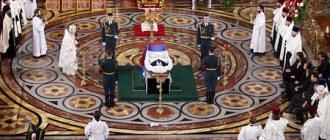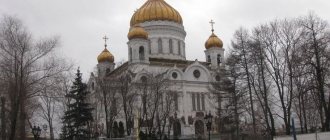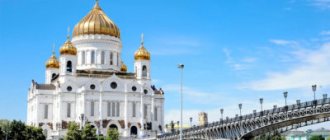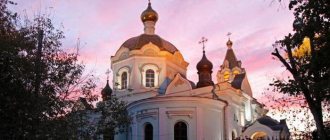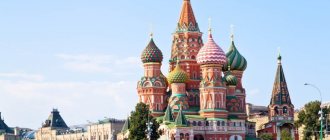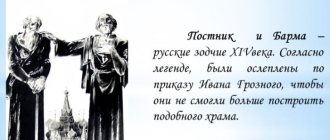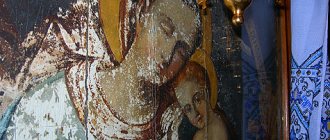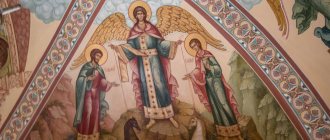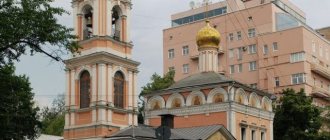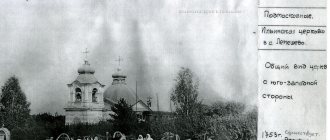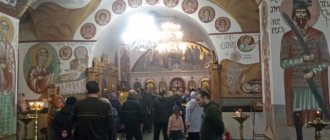The Cathedral of Christ the Savior is the main church of the capital of Russia. This is a beautiful Cathedral of the Orthodox Church, which is located near Red Square and the Kremlin. The rector is Patriarch Kirill of Moscow and All Rus'. The object appeared as a sign of gratitude to God during a difficult period for Russia. We all remember the terrible Napoleonic invasion that occurred in 1812. For Russia during this period a series of trials began. The temple serves as a monument to the Russian people for valor, heroism, and endurance.
The monastery project was developed in 1883. The development was undertaken by architect K.A. Tone. The church took quite a long time to build. The whole process took 44 years. The laying of the first stone church took place in 1839. In 1931 - the period of the Stalinist revolution. The object was destroyed. In the 90s The shrine began to be rebuilt from scratch. Today's temple that we see was built during the Soviet period.
The Cathedral of Christ the Savior is used for major anniversaries and celebrations. This is one of the main city attractions where the foundations of religious life are laid. This is an object of culture and socio-political life in Russia. It has an official website, which you can always go to in order to get acquainted with the service schedule.
Cathedral of Christ the Savior: briefly the most important
The current Cathedral of Christ the Savior in Moscow is, in fact, the third.
The first Cathedral of Christ the Savior - designed in 1817
. It should have looked completely different from the current one (and frighteningly different), and it should have stood in a completely different place. Its construction stopped as soon as it began.
The second one was erected in 1883
, looked almost exactly like the current one, and was destroyed by the Soviet authorities in 1931.
The current Cathedral of Christ the Savior
was completed by 2000.
General information
An architectural ensemble, according to the Great Soviet Encyclopedia, is considered to be a solid, harmonious composition of buildings. In a broader sense, this definition applies to works of monumental painting, sculptures and park design, and various architectural and engineering structures. Visualization of an architectural ensemble is mostly created through details and images, such as the presence of people nearby or changes in weather conditions. It is also worth noting that the terrain, especially natural bodies of water (rivers, lakes), can play an important role here.
Cathedral of Christ the Savior - dimensions
This is one of the largest Orthodox churches in the world, and in terms of height it is the first of all.
Height of the Cathedral of Christ the Savior
- 103 meters, that’s almost 40 floors in a residential building. (besides it, only St. Isaac’s Cathedral in St. Petersburg and, according to some sources, the Trinity Cathedral of Tsminda Sameba in Tbilisi are higher than one hundred meters)
By capacity
(10,000 people) it is among the top five in the world.
By area
- 60 by 60 meters - this majestic temple is also one of the largest in the world (larger: Tsminda Sameba in Tbilisi - 77 by 65 meters; and the Church of St. Sava in Belgrade - 91 by 81 meters).
See also: The largest Orthodox churches
At the same time, the first Cathedral of Christ the Savior was supposed to be an even larger-scale structure, and a completely different architectural style.
Construction collapse
Until it catches fire: how a careless attitude towards antiquity can lead to tragedy
And who should be responsible for the revival of small towns
The war undermined the state’s finances—the treasury was almost empty. They announced a nationwide subscription, hoping for help from different sectors of society. However, the collection of donations was not at all as active as expected, and only a few years later the amount was collected to allow the work to begin, and even that was mainly contributed by the emperor. On the fifth anniversary of the beginning of the French retreat from Moscow, October 12, 1817, the ceremonial foundation stone of the temple took place. The emperor and his family, the court, heroes of recent battles, and foreign guests were present. About 400 thousand Muscovites gathered for the event - a good half of the city. “There were more than 30 archpriests, about 300 priests, and about 200 deacons... two choirs of singers - court and synodal... in the best and richest vestments.” On this occasion, Vitberg was awarded the rank of collegiate assessor and the Vladimir Cross, he received the title of academician of architecture, hereditary nobility and family coat of arms. The architect converted to Orthodoxy, and Alexander I himself became his godfather. In honor of his patron, Charles Magnus was named Alexander, and it was under this name that he entered the history of Russian architecture.
Fragment of the “Plan of the Capital City of Moscow”, completed in 1819 by officers of the Military Topographical Depot, indicating the location of the proposed construction of the Cathedral of Christ the Savior on Sparrow Hills
Photo: commons.wikimedia.org
Behind the Kremlin wall: how to live in a monument house in Suzdal
Inhabitants of historical casemates are required to make repairs on their own and at their own expense, and there are no amenities even in the yard
As some experts predicted (for example, Colonel Nikolai Ivanovich Yanish), the builders faced enormous difficulties. The fact is that clay and sandy soils “floated” down the slope under load, which is why large-scale and very expensive engineering and excavation work had to be carried out. Almost all available funds were spent on them, but there was no visible result - in seven years it was not even possible to complete the “zero cycle”. The emperor continued to believe in his godson and supported him, but in 1825 Alexander I died.
Nikolai Pavlovich, who ascended the throne, created a commission - the “Artificial Committee”, chaired by engineer-general K.I. Opperman. The famous engineers and architects who were included in it, after serious research, issued a verdict - it is impossible to build on the edge of the Sparrow Hills, the soils will continue to “float” along the slope. On May 11, 1827, the Senate issues a decree: “The commission on the construction of a temple in Moscow in the name of Christ the Savior is to be closed, and its affairs, officials, buildings, prepared materials and all government departments and its property are to be transferred to the jurisdiction of the Moscow military governor-general and actual privy councilor.” Prince Yusupov." During the transfer of cases, a huge shortage was revealed - almost a million rubles disappeared. An investigation began that lasted seven years. Vitberg’s personal self-interest was not revealed, however, the architect was accused of not looking after thieving contractors and was exiled to Vyatka. His property was confiscated. The imperial godson spent the rest of his life in poverty and obscurity, doing odd jobs.
Photo: commons.wikimedia.org
Colored engraving by A. Afanasyev “Historical image of the celebration that took place during the foundation of the Cathedral of Christ the Savior on the Sparrow Hills on October 12, 1817”
The first Cathedral of Christ the Savior
The height of the Cathedral of Christ the Savior is now 103 meters. Impressive. But the height of the cathedral, which was originally planned in the 19th century, was supposed to be even greater - 240 meters!
And it was supposed to be not so much a temple as a monument to the fallen soldiers in the War of 1812. A whole complex that included both the cathedral and the infrastructure around it - colonnades, pantheons (including those for monarchs).
Did it look like an Orthodox church? No, absolutely. It was not even designed by an Orthodox person, but by a Lutheran, Karl Witberg (although, in order for the construction to take place, he nevertheless converted to Orthodoxy).
How could all this even happen?
Perhaps because Alexander I, who announced the competition, was a fan of Western architecture? It was under him that the project of St. Isaac’s Cathedral was developed, which also has nothing in common with Russian tradition...
The construction of the Cathedral of Christ the Savior was stopped at the foundation stage. Partly because there were major miscalculations in the organization, partly because of the unreliability of the soil, and partly because of the massive waste that emerged. Vitberg himself was arrested for this and sent into exile.
Interiors of the largest temple in Russia
The total area of painting on the walls of the temple exceeds 22 thousand square meters. m, with 9 thousand sq. m of them are gilded surfaces. A gallery has been created along the perimeter of the walls, on the walls of which hang memorial plaques describing the battles carried out by the Russian army. Here you can see the names of famous commanders, as well as soldiers who distinguished themselves in battle.
Inside the cathedral there are decorations made of decorative stones, paintings and sculptures. The high walls are painted with images of Christian saints and princes who did not spare their lives for the sake of their Motherland. In the lower gallery, the names of heroes of the Patriotic War are written on boards. The picturesque decoration of the temple was created by a whole group of masters, led by academician and honored artist of the country N.A. Mukhin.
Sculptural composition on the walls of the temple
Cathedral of Christ the Savior before destruction
In 1837, construction began on the new Cathedral of Christ the Savior. The architect was Konstantin Ton (he is responsible for many large projects - including the Grand Kremlin Palace and the Armory Chamber - one of the largest architects in Russian history).
That cathedral looked almost exactly the same as the current one and was located in the same place as the current one - on Volkhonka, on the banks of the Moscow River.
There is no longer any “Latin” architecture in this project. The cathedral is huge, majestic, innovative in some things (how could it be otherwise with such dimensions?), but absolutely in the spirit of Russian traditions. At this time, Nicholas I was already ruling Russia. It is believed that he personally chose this project for the Cathedral of Christ the Savior.
This temple, like the first project, was erected in memory of the soldiers who fell in the battles of 1812 and was equally both a temple and a monument to them, but this time it was a cathedral, and not a memorial complex.
The Cathedral of Christ the Savior was blown up in 1931: in order to build in its place an even larger structure - the Palace of Soviets - an architectural structure striking in its size with a giant Lenin and a helipad on his arm. The height was planned to be 495 meters - in terms of residential buildings, this is more than 150 floors.
LiveInternetLiveInternet
© RIA Novosti. V. Shiyanovsky | Buy illustration
The Cathedral of the Moscow Diocese and the entire Russian Orthodox Church - the Cathedral of Christ the Savior in Moscow was built as a memorial church dedicated to the Patriotic War of 1812.
The idea of erecting a temple in honor of Russia's victory over Napoleon's army belonged to Army General Mikhail Kikin and was transferred to Russian Emperor Alexander I.
At the end of 1812, Alexander I issued a manifesto on the creation of the temple in commemoration of “gratitude to the Providence of God, which saved Russia from the destruction that threatened it.” On October 24 (12 old style), 1817, the ceremonial laying of the Cathedral of Christ the Savior took place on the Sparrow Hills, but the project was not implemented, as problems arose related to the fragility of the soil, which has underground streams. After the death of Alexander I in 1825, the new Emperor Nicholas I ordered the suspension of all work, and construction was stopped in 1826.
On April 22 (10 according to the old style) April 1832, Emperor Nicholas I approved a new design for the Temple, drawn up by the architect Konstantin Ton. The Emperor personally chose the location for the construction of the Cathedral of Christ the Savior - on the banks of the Moscow River, not far from the Kremlin, and in 1837 established a special Commission for the construction of a new Temple. The Alekseevsky Convent and the Church of All Saints, located on the site where the Cathedral of Christ the Savior was supposed to be built, were dismantled, and the monastery was transferred to Krasnoe Selo (now Sokolniki).
On September 22 (10 old style), the ceremonial laying of the new temple took place.
Your browser does not support this video format.
(2:07 / 12.90Mb / video views: 4888)
RIA News.
Your browser does not support this video format.
© RIA Novosti
The fate of the Cathedral of Christ the Savior. Archive footage for the 130th anniversary of the consecration of the Cathedral
In plan, the temple had the shape of an equal-ended cross. Byzantine was chosen as the basis of his style. The height of the temple from the base to the cross was 103.5 meters (the height of the cross was 8.5 meters). The walls, the thickness of which reached 3.2 meters, were made of brick and partly white stone. The cladding was made of Italian marble of different types. Four powerful pylons supported the central drum. At the ground floor level, the building was surrounded by a corridor - the first museum of the War of 1812, where all the battles, distinguished units and their commanders, the names of the dead and awarded officers were immortalized on white marble boards. High reliefs by sculptors Alexander Loganovsky, Nikolai Ramazanov, and Pyotr Klodt were placed on the facades. The interior of the temple was illuminated by 60 windows. A large group of artists worked on the picturesque decoration of the temple for 23 years, among whom were famous painters Henryk Semiradsky, Vasily Surikov, Konstantin Makovsky and others.
The temple took almost 44 years to build. In 1841 the walls were leveled with the surface of the plinth; in 1846 the vault of the large dome was built; three years later, the exterior cladding work was completed and the installation of metal roofs and domes began. The vault of the large dome was completed in 1849. In 1862, a bronze balustrade was installed on the roof, which was missing in the original design. By 1881, work on the embankment and square in front of the temple was completed, and external lanterns were installed.
On December 25 (13 old style), 1880, the new church was given the name of the Cathedral of Christ the Savior, and the staff of the clergy and clergy were approved.
On June 7 (May 26, old style), 1883, on the Feast of the Ascension of the Lord, the solemn consecration of the temple took place, coinciding with the coronation day of Emperor Alexander III. On June 24 (12, old style) of the same year, the consecration of the chapel in the name of St. Nicholas the Wonderworker took place, and on July 20 (8, old style), the second chapel was consecrated in the name of St. Prince Alexander Nevsky. From that time on, regular services began in the temple. Since 1901, the church established its own choir, which was considered one of the best in Moscow. In the spring of 1912, a monument to Emperor Alexander III was erected in the park near the temple, which was destroyed in 1918.
© RIA Novosti
Demolition of the monument to Alexander III on the square near the Cathedral of Christ the Savior
Coronations, national holidays and anniversaries were solemnly celebrated in the temple: the 500th anniversary of the death of St. Sergius of Radonezh, the 100th anniversary of the Patriotic War of 1812, the 300th anniversary of the House of Romanov. In August 1917, the opening of the Local Council took place in the Cathedral of Christ the Savior, at which, after a 200-year break, Patriarch Tikhon was elected, now canonized by the Russian Orthodox Church. In February 1918, to prevent the closure of the temple, the Brotherhood of the Cathedral of Christ the Savior was created, which actually maintained the temple. In 1922-1923, the temple was captured by renovationists, and in 1931 it was closed.
© RIA Novosti. Dmitry Debabov |
Removing the bells from the Cathedral of Christ the Savior. 1930
By decision of the Soviet government, on December 5, 1931, the temple was blown up. Some of the external white stone bas-reliefs, which were later mounted into the wall of the Donskoy Monastery, have been preserved.
© RIA Novosti. Vladimir Vyatkin |
Fragments of the high relief of the Cathedral of Christ the Savior, destroyed in 1931, stored in the Donskoy Monastery
On the site of the temple it was planned to build a grandiose structure of the socialist era - the Palace of Soviets. The Great Patriotic War (1941-1945) did not allow these plans to be implemented. After the war, the foundation of the unfinished building was used to build the Moscow outdoor swimming pool (1960-1994).
© RIA Novosti. Ivan Denisenko
Pool "Moscow"
In September 1994, the Moscow government decided to recreate the Cathedral of Christ the Savior in its previous architectural forms.
On January 7, 1995, on the feast of the Nativity of Christ, Patriarch of Moscow and All Rus' Alexy II, together with the mayor of the capital Yuri Luzhkov, laid a memorial capsule at the base of the temple.
© RIA Novosti. Alexander Makarov |
Construction site of the Cathedral of Christ the Savior
The temple was built in less than six years. The first construction work began on September 29, 1994. On Easter 1996, the first Easter Vespers was celebrated under the arches of the church. In 2000, all internal and external finishing work was completed.
© RIA Novosti. Boris Prikhodko
Construction of the Cathedral of Christ the Savior. 1995
On August 19, 2000, on the day of the Transfiguration of the Lord, Patriarch Alexy II performed the Great Consecration of the Cathedral of Christ the Savior.
The architectural design of the Cathedral of Christ the Savior complex was developed by the Mosproekt-2 management together with the Moscow Patriarchate. The project manager and chief architect is academician Mikhail Posokhin. Work on recreating the artistic decoration was carried out by the Russian Academy of Arts, headed by its president Zurab Tsereteli; 23 artels of artists took part in the painting. The reconstruction of the sculptural decoration of the facades of the temple was carried out under the leadership of Academician Yuri Orekhov with the assistance of the Sculptor Foundation. The bells were cast at the I.A. Plant. Likhacheva (AMO ZIL).
© RIA Novosti. Igor Mikhalev |
Consecration and raising of the Great Bell to the belfry of the Cathedral of Christ the Savior
The recreated temple is reproduced as close to the original as possible. During the design and construction work, information from the 19th century was used, including sketches and drawings. The modern temple is distinguished by its stylobate part (ground floor), erected on the site of the existing foundation hill. This building, 17 meters high, houses the Church of the Transfiguration of the Lord, the hall of Church Councils, the meeting hall of the Holy Synod, refectory chambers, as well as technical and service rooms. Elevators are installed in the columns of the Temple and in the stylobate part. The walls and supporting structures of the temple are made of reinforced concrete followed by brick cladding. For the exterior decoration, marble from the Koelga deposit (Chelyabinsk region) was used, and the plinth and stairs were made of red granite from the Balmoral deposit (Finland).
© RIA Novosti. Vladimir Fedorenko |
Cathedral of Christ the Savior in Moscow
The Cathedral of Christ the Savior is the largest cathedral of the Russian Orthodox Church, it can accommodate up to 10 thousand people. The total height of the building is 103 meters, the internal space is 79 meters, the thickness of the walls is up to 3.2 meters. The area of the temple's paintings is more than 22 thousand square meters.
The temple has three altars - the main one, consecrated in honor of the Nativity of Christ, and two side altars in the choir - in the name of St. Nicholas the Wonderworker (south) and St. Prince Alexander Nevsky (north).
© RIA Novosti. Sergey Subbotin |
Altar in the Cathedral of Christ the Savior
Among the main shrines of the temple are a particle of the robe of Jesus Christ and the Nail of the Cross of the Lord, a particle of the robe of the Most Holy Theotokos, the holy relics of Metropolitan Philaret (Drozdov) of Moscow, the head of St. John Chrysostom, particles of the holy relics of the Apostle Andrew the First-Called, Metropolitans Peter and Jonah of Moscow, and princes Alexander Nevsky and Michael of Tverskoy, Venerable Mary of Egypt. In the temple there are miraculous images of the Vladimir Mother of God and the Smolensk-Ustyuzhensk Mother of God.
The Cathedral of Christ the Savior is the Cathedral of the Russian Orthodox Church. The rector of the temple is Patriarch Kirill of Moscow and All Rus', the key keeper is Archpriest Mikhail Ryazantsev.
The material was prepared based on information from RIA Novost https://ria.ru/spravka/20130608/941627670.html RIA Novosti https://ria.ru/spravka/20130608/941627670.html#ixzz3iZnFXVkb https://ria.ru/spravka /20130608/941627670.html
Swimming pool on the site of the Cathedral of Christ the Savior (photo)
However, the construction of the Palace of Soviets did not work out. There were many reasons, but all of them were of an exclusively practical nature, and not mystical (as some people believed) - high cost, the outbreak of war, etc....
As a result, an outdoor swimming pool appeared - it seems to be the largest in Europe. It was so large that the fumes caused corrosion on nearby buildings!
The pool on the site of the Cathedral of Christ the Savior was called “Moscow”. And it existed from 1960 to 1994.
How to get there
The Family Suitcase company organizes excursions to monasteries
Travel from Yoshkar-Ola
Travel from Cheboksary
Travel from Kazan
Most residents of the capital and visitors prefer to use the metro. The nearest metro station is Kropotkinskaya. It is also convenient to use such stations as Teatralnaya, Aleksandrovsky Sad, Arbatskaya. From the stop you can walk to the monastery. At the same time, along the way you will be able to admire other sights around.
The current Cathedral of Christ the Savior
The cathedral that we see now was opened on December 31, 1999, and on Christmas Day 2000 the first Liturgy was served there.
The temple was built solely on donations.
Externally, it is an almost complete copy of the former Cathedral of Christ the Savior - with minor exceptions.
Cathedral of Christ the Savior shortly after restoration.
Keeping promises
Nicholas could not fail to fulfill his elder brother’s vow, and for him, the War of 1812 was a significant event. He was eager to go to the front, but the emperor forbade the grand dukes to participate in battles. This was a thorn in the soul of Nicholas, who was surrounded at court by veterans and war heroes, many of whom were his peers.
The fire of Europe: what does the burnt Notre-Dame Cathedral symbolize?
One of the symbols of Christian civilization is practically destroyed
The competition was announced again, and again the best creative forces of the country took part in it. The Emperor did not like any of the projects. And then in 1831 he personally appointed Konstantin Andreevich Ton as the chief architect. The reasons for this decision are not entirely clear, since the architect had one church built and several not very significant works. Ton was just over thirty, and he spent most of his adult life in Italy, where he was sent after excellent graduation from the Academy of Arts. In the Apennines, he achieved some success - for the restoration projects of the Temple of Fortune in Praeneste and the complex of imperial palaces on the Palatine Hill in Rome, Ton even received the title of academician. This was appreciated at home, and in 1828 Ton was personally invited by the emperor to work in the Cabinet of His Majesty. Soon the young architect received an order to build the Church of Catherine the Great Martyr in Yekateringof, which he completed in the national style with references to Byzantine and Old Russian traditions. Nicholas liked the church. Thon also impressed the monarch with his thriftiness with public money: he not only did not ask to increase the estimate (which was the norm), but even managed to save some of the allocated funds. The sovereign, who did not tolerate embezzlers, appreciated this.
The ideological aspect is also important, because the construction of the temple in honor of the victory had a symbolic and political meaning. The vast majority of works submitted to the competition were executed in the manner of European classicism. But Nikolai did not like Western influence and was partly afraid. And the project proposed by Ton in the Byzantine-Russian style fit much better into the sovereign’s worldview - there was only a year left before Count Uvarov proclaimed the famous triad “Orthodoxy, autocracy and nationality.” Nicholas decided not to announce a subscription, but to build the cathedral using funds from the treasury. Therefore, he considered it possible to reserve the right to choose the project and the architect.
Photo: commons.wikimedia.org
Portrait of Konstantin Ton by Karl Bryullov
By 1832, Thon’s project was approved, but there were no convenient and free territories left in the already restored Moscow, something had to be sacrificed. Based on the competitive proposals of Moscow architects, Thon presented Nikolai with three options to choose from: behind the Orphanage, where the Church of St. Nicholas the Martyr on the Cross above the Moscow River (Shvivaya Gorka), on Tverskaya Street on the site of the Strastnoy Monastery (current Pushkin Square) and on the site of Alekseevsky convent in Chertolye, between the Bolshoy Kamenny Bridge and the Prechistensky Gate. The Emperor chose the latter. And the monarch’s decision again turned out to be reckless...
A frivolous genius: how Fyodor Shekhtel changed the face of Moscow
The author of the Yaroslavl station building project never received an architect's diploma
“This place should be empty”
The history of the Alekseevsky Monastery goes back to the 14th century, when Moscow Metropolitan Alexei Fedorovich Byakont (educator of Dmitry Donskoy and de facto ruler under the young prince) decided to found the first women’s monastery in the city. The monastery was located behind the Chertoryi stream, closer to the Crimean Ford and was consecrated in honor of the conception of St. Anna, which is why it was called Zachatyevsky. Its first inhabitants were the sisters of Metropolitan Alexy, who took the names of Juliania and Eupraxia in monasticism. The monastery stood for two hundred years. In the 16th century, it was repeatedly plundered by the Krymchaks and Nogais. After another defeat and fire at the old place, they decided not to restore it, but to move it under the protection of the fortress wall of the White City. So he ended up on Volkhonka, near the Prechistensky Gate. During the construction of new buildings, temples were erected both in honor of Alexy, the man of God, and in honor of the conception of St. Anna. But the people now called the new monastery Alekseevsky. In the 30s of the 17th century, masters Antip Konstantinov and Trefil Sharutin, by royal decree and in gratitude for the birth of the long-awaited heir (the future Tsar Alexei Mikhailovich), built a small but elegant two-tent temple in the monastery, which was considered one of the most beautiful churches in the capital. Soon the construction of churches of this type was prohibited by Patriarch Nikon as not complying with the canon, and the cathedral of the Alekseevsky Monastery became completely unique.
Painting by Karl Rabus “Alekseevsky Monastery”
Photo: commons.wikimedia.org
Cult of personalities: St. Petersburg Bolshoi Drama Theater and its legends
The names of Blok, Gorky and, of course, Tovstonogov are associated with the history of the theater.
But, despite its 400-year history, they decided to demolish the monastery, and the sisters were ordered to move to the Krasnoye Selo area (the area of the current Krasnoselskaya metro station). There is a legend that when the nuns held their last service, the abbess of the monastery, Abbess Claudia, ordered herself to be chained to an old oak tree growing in the middle of the monastery courtyard. She had to be expelled by force, and in the midst of this ugly scene the abbess uttered a curse: “This place should be empty!”
